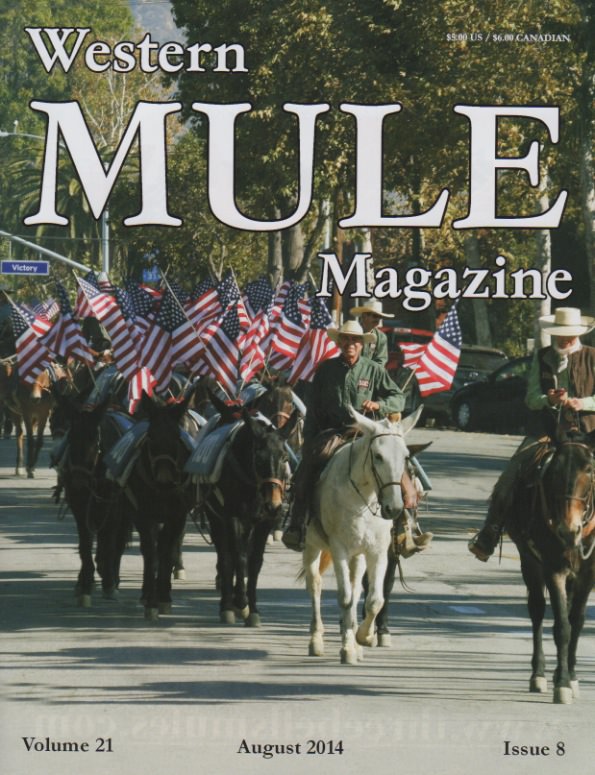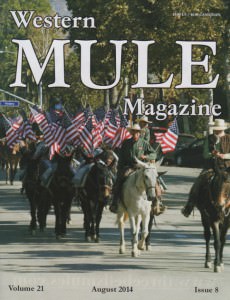 As published in the August 2014 issue of Western Mule Magazine
As published in the August 2014 issue of Western Mule Magazine
We’ve all heard it “ a good horseman, and woman, should carry a knife”. But how many of us actually follow this saying? Do you? I speak at a fair number of equine events across the country each year for my navigation and horse camping seminars and the “do you carry a knife?” question is a one that I’ll frequently bring up with my audiences. Often I’m shocked by how many people who trail ride don’t carry this simple and to my mind, vital piece of equine equipment.
The presence of a good blade can be the difference between a great ride and a horrid catastrophe. Consider the following situations that we’ve all been in where a good knife would come in quite handy.
- A horse that has become tangled in a too loose lead line and the slip-knot is stuck. A quick flick and the drama is ended. Early in my riding days I once (emphasis on once) thought it would be a good idea to put my saddled animal back on the highline for a moment. Less than 3 minutes later my horse was in quite the bind. Luckily I had a sharp knife with me. I still miss that lead line.
- Your mule steps on a rein and breaks it. Repairs go so much more smoothly when you have a good knife handy. From punching new holes to cutting new pieces parts, a knife can make the difference between walking back to the trailhead or continuing the ride into that special area.
- Your horse gets tangled. I was riding with a dear friend who somehow got a stout branch through a girth ring, while we were in a deep muddy area. The latigo was what I could find through the thick mud. A very careful cut and the pony was free. Several more cuts to affect the repair and we were off. I avoid that muddy bog now.
- Last but certainly not least a good knife can not only clean that high mountain trout for dinner, it can also cut an apple to share with your mule.
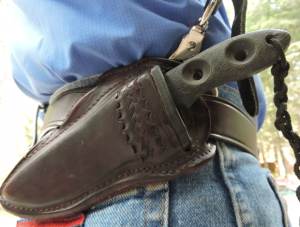 For thousands of years, humans have depended on blades of some kind to help meet basic survival needs: food, water, fire, and shelter. Now that we’ve talked about just a few of the many times a trail rider will find a knife useful let’s discuss what features you’ll want to consider when choosing a knife.
For thousands of years, humans have depended on blades of some kind to help meet basic survival needs: food, water, fire, and shelter. Now that we’ve talked about just a few of the many times a trail rider will find a knife useful let’s discuss what features you’ll want to consider when choosing a knife.
Size Does Matter – You’re not Rambo nor are you likely to storm the beaches of Iwo Jima so a huge knife worthy of these pseudo-romantic notions is really out of the picture. Indeed not only is a smaller blade much easier to carry it’s much better at cutting a rope without injuring anyone. I like a knife with a blade length of about 3 inches; it’s perfect to get to the last of the peanut butter while not being so big as to be unwieldy.
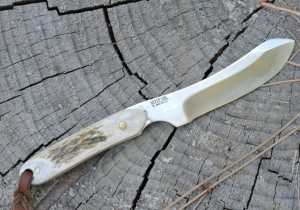 Fixed or Folding? – A fixed blade is far more durable and reliable than a folding blade knife. The joint that makes a pocketknife convenient to carry is also a major point of weakness. Also, the time it takes to fish your knife out from your pocket and open it can be the time it takes for a situation to get really, really, bad. For those fond of folding blade knives make sure that you get one that you can open with one hand and that has a mechanism that will lock the blade in place once it’s open to prevent it from closing on your hand when you’re using it. I carry two knives. A fixed blade in a belt sheath that is ready at an instant for emergencies; cleans fish; and the aforementioned backcountry PB and jelly sandwiches. The folding blade knife lives in a pocket and has repaired more than its fair share of broken tack.
Fixed or Folding? – A fixed blade is far more durable and reliable than a folding blade knife. The joint that makes a pocketknife convenient to carry is also a major point of weakness. Also, the time it takes to fish your knife out from your pocket and open it can be the time it takes for a situation to get really, really, bad. For those fond of folding blade knives make sure that you get one that you can open with one hand and that has a mechanism that will lock the blade in place once it’s open to prevent it from closing on your hand when you’re using it. I carry two knives. A fixed blade in a belt sheath that is ready at an instant for emergencies; cleans fish; and the aforementioned backcountry PB and jelly sandwiches. The folding blade knife lives in a pocket and has repaired more than its fair share of broken tack.
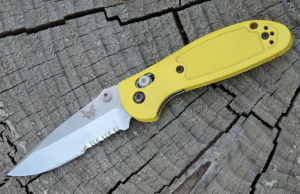 Serrated or Smooth? Ideally your knife should have a blade with both a serrated edge and a smooth edge. The smooth edge cuts everything, the serrated edge is great for ropes.
Serrated or Smooth? Ideally your knife should have a blade with both a serrated edge and a smooth edge. The smooth edge cuts everything, the serrated edge is great for ropes.
Your knife needs to fit – Fit what you say? Your hand. The knife that a ham-fisted lumberjack finds comfortable would be more of a small sword for most women. Go to a reputable sporting goods store and see which knifes feel best in your hand. The knife that you’re most comfortable with is the one that won’t be “forgotten” back at home when you’re on the trail.
Just as horses and mules have had an incredible impact on humankind over the ages so too have the cutting blades that helped to shape how our ancestors hunted, built, and survived. Choosing the tool that best fits you and your chosen sport of trail riding is an important consideration. Choose yours wisely.
As always for information on this, and many other topics of interest to trail riders please visit www.www.trailmeister.com, the largest horse trail and camping area directory in North America, and the only trail listing that is verified for accuracy.


